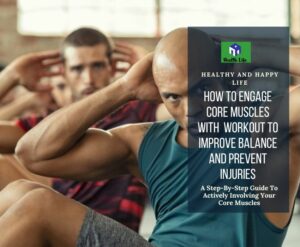Even if you’ve never seen a workout program, read a fitness magazine, or stepped foot inside a gym, it’s likely that you’ve at least heard the phrase “activate your core” at some point in your life. If you haven’t, you should. When you’re on your last rep, sometimes it’s whispered in your ear, and other times someone may yell it at you when you’re working up a sweat.Having said that, it’s possible that you’re unsure of what your core is, what it means to “activate” it, and how to do so. Here is going to explorer about, how to engage core muscles in the body with different exercises?
Your abdominals, obliques, diaphragm, pelvic floor, trunk extensors, and hip flexors are all included in the group of muscles known as your core, which surrounds and supports your trunk.
Your abdominal muscles provide stability to your trunk, which helps with things like maintaining balance and performing activities like lifting weights and rising from a chair. Additionally, it offers mobility so that your torso can move as required, such as when you reach for your seatbelt or swing a golf club. This is useful in situations where you need to move your torso.
In addition, the core muscles in your body are used in a variety of day-to-day actions, including breathing, controlling your posture, urinating, and defecating.

When you inhale and exhale, your diaphragm is one of the primary muscles responsible for facilitating the movement of air into and out of your lungs. When you sit up tall, the muscles in your core tighten to help keep your trunk in an upright position. They are there to help you get started on and finish your business when you use the restroom.
This article provides an explanation of what the core muscles are, examines the role they play in maintaining the mobility and stability of the trunk, and then reviews some core exercises that can be incorporated into a training routine.
What Muscles Make Up The Core Of Your Body?
Several muscle groups make up your core muscles.
Rectus Abdominis.
Your lower ribs and the front of your pelvis are the attachment points for the rectus abdominis muscle, which is also referred to as the “six-pack” muscle. Flexing your spine is the major movement that it does, and examples of this include sitting up in bed or performing crunches.
This muscle is the most superficial of the core muscles, and as a result, it does not contribute as much to maintaining the stability of the spine.
Internal And External Obliques.
Both the internal and external obliques have attachment points on the lateral sides of the trunk, which extend from the ribs down to the pelvis. They offer support and stability to the front and sides of the trunk in a static position.
Their principal actions involve bending to the side and rotating their trunks, similar to how you might move when swinging a baseball bat. When they act together on both sides, they stretch the spine as well.
Transversus Abdominis.
The origin of the transversus abdominis muscle can be found in a variety of locations, such as the back and top of the pelvis as well as the lower six ribs. Its fibers travel in a horizontal direction across the body until they reach the linea alba, also known as the midline. It is the abdominal muscle that is the most deeply seated, and its function is to give support for the spine.
When the transversus abdominis muscle is activated, it works in conjunction with the multifidus muscle to produce a cocontracting action that supplies deep segmental stability to the lower back in particular.
The strengthening of these muscles is often beneficial for people who suffer from persistent low back pain.
Pelvis Floor
The muscles that make up the pelvic floor are situated on the underside of the pelvis, and their function is analogous to that of a hammock or sling. When activated, they go upward toward the stomach and engage the user.
In addition to their role as deep stabilizers of the spine and pelvis, these muscles are responsible for initiating and terminating the flow of urine and feces.
Diaphragm
The underside of your lower ribs are where the diaphragm is attached to in your body.It is the primary muscle that is responsible for breathing in and out, but recent research suggests that it also plays an important role in the function of the heart, the return of lymph, the regulation of emotional states, swallowing and vomiting, the stabilization of the lumbar spine, and pain tolerance.
Back Extensors.
The erector spinae muscles, the quadratus lumborum, and the multifidus are all components of your back’s extensor muscles, which are multilayered muscles. In general, they are responsible for connecting the spine to the pelvis or for attaching a specific vertebra to the vertebrae above and below it.
The basic tasks of these muscles include spinal extension (bending backward), support for posture, and support for the spine when bending forward and raising loads, such as when performing squats or bicep curls.
Iliopsoas.
Both the iliacus and the psoas major are considered to be hip flexors; however, because they converge into one muscular belly, they are more commonly referred to as the iliopsoas. They insert on the femur, also known as the upper leg bone, and they originate from the thoracic and lumbar spine (psoas) as well as the iliac crest of the pelvis (ilacus).
When you execute high knee movements, for example, you are contracting the iliopsoas muscle, which bends the hip joint and brings the legs closer to the body. On the other hand, due to the fact that it is also related to the spine, it is regarded to be a deep core stabilizer.
How To Engage Core Muscles?
The phrase “engage your core muscles” can refer to a variety of different things, depending on what it is that you are trying to do. If you try to maintain your balance while standing on one leg, for example, the muscles that are recruited and the order in which they fire will be very different from those that are recruited and fired when you are doing situps.
In addition, the sensations that you get from engaging your muscles will be different depending on a number of factors, such as whether you are trying to move your spine or stabilize it, whether you are pushing or pulling weight, and whether you are standing, sitting, or lying down when you do the exercise.
It doesn’t matter how, when, or why you engage your core; what’s most important is that you understand how each of these muscles works in concert with the others when you’re moving. They do not function properly when used alone.
It is essential to be able to activate your core in every circumstance and in any fashion in order to achieve a fully strong and functional core. By doing so, you will be able to provide dynamic stability and spinal support for your moving body. In order to accomplish the goals of this post, we will concentrate on discussing the following four key techniques to engage your core:
A Concentric Contraction Of The Abdominal Muscles Or The Back Muscles.
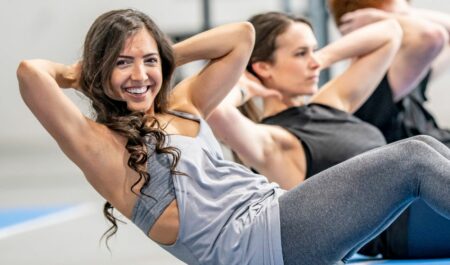
When you perform a standard abdominal exercise like a crunch or a back exercise like the superman, you are engaging your core muscles and employing them as the primary movers in the movement.
For instance, when you perform a crunch, your rectus abdominis and obliques contract concentrically, which means that they shorten. This causes your rib cage to move closer to your hips, which in turn lifts your shoulders and head.
For the purpose of generating movement or accelerating the body, concentric contractions are utilized.
These are the types of muscle contractions that the majority of individuals are most accustomed to experiencing.
Abdominal Or Back Muscles Contracting In An Eccentric Manner.
In order to slow down the force being exerted by the body or the movement it is making, eccentric contractions are utilized. They are known as lengthening contractions and invariably occur in conjunction with a concentric contraction that takes place on the opposite side of the joint.
For example, if you are sitting at your computer and realize that you are drooping, when you straighten your back and lift your spine, two contractions will occur: concentric contractions in the spinal extensors and an eccentric contraction, which is a contraction that lengthens the abdominals.
Both are necessary for the proper operation of the core.
Abdominal Bracing.
An abdominal brace is a contraction of the isometric muscles that line your abdominal wall. This type of contraction does not cause your spine, ribs, or pelvis to move or change position in any way.
When transferring big loads, such as when lifting weights, it is utilized as a means of providing protection for the spine.
According to the findings of recent studies, abdominal bracing is the most effective method for engaging the superficial abdominal muscles.
A Drawing In Or Hollowing Out Of The Abdominal Region.
When you concentrate on bringing your navel to your spine, you are performing the abdominal draw-in motion, which is also referred to as abdominal hollowing. This form of contraction is utilized for stability, such as bracing, and it is most effective when thought of as a dynamic element of your exhale. Examples of this type of contraction include:
It has been demonstrated through research that hollowing down the abdominals, also known as drawing the abs in, is a more effective method than bracing for engaging the deep spinal stabilizers and the transversus abdominis.
The most functional core is one that is able to perform both the bracing and hollowing techniques effectively and uses each method when it is necessary. There are advocates of both types of core stabilization contractions, but the most functional core is one that can perform both techniques effectively.
Exercises Aimed Towards Strengthening The Core.
You can engage your core by performing the basic abdominal stability exercises that are listed below. They are by no means comprehensive, but they are important in comprehending how to activate the muscles in your core.
The Abdominal Draw

- Place yourself on your back and bend your knees. (You are also able to accomplish this while seated in an upright position.) Inhale.
- Exhale as you draw your stomach in toward your spine and visualize bringing your belly button closer to your spine. You should not have any trouble breathing, but you may become aware of the muscles in your belly and sides becoming more contracted. Make sure that your back is not arched or pressed into the ground in any way; it shouldn’t move at all.
- Keep holding for five to ten seconds. Relax.
- Repeat.
The Plank.
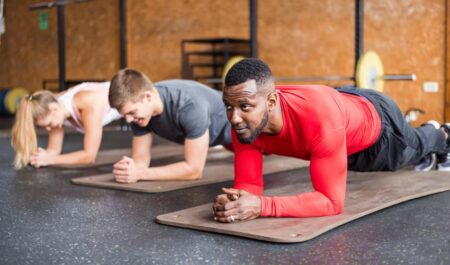
- Put your hands and toes together in a pushup posture to begin. If you find that this is too challenging for you, you can bring yourself down to your knees.
- To achieve proper posture, you should pull your stomach in toward your spine and ensure that your buttocks are in alignment with the rest of your body. You must to be able to feel the contraction of every abdominal muscle.
- Maintain this position for twenty to sixty seconds.
It is essential that you take into consideration the fact that this workout places large strains on your spine. If you have back pain, it is recommended that you avoid doing this exercise or that you modify it by doing a plank against a wall or by doing a plank on your knees.
The Side Plank
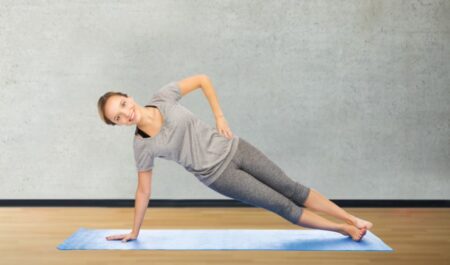
- Position yourself so that you are lying on your side with one foot on top of the other. Your elbow should be resting on the floor. Your upper body will be elevated in this position. For even more stability, you can either reach your top arm to the sky or keep the hand on the ground.
- Raise your hips into the air and straighten your legs such that you are able to balance yourself on the side of your foot and your forearm. If you find that this is too difficult for you, keep your knees on the ground and draw a straight line from your knees to your head.
- Always remember to keep your feet, hips, and elbows in proper alignment. In addition to this, be sure that your shoulder is over your elbow. You should feel the oblique muscles on the bottom side of your body functioning.
- Maintain this position for twenty to sixty seconds.
The Bird Dog
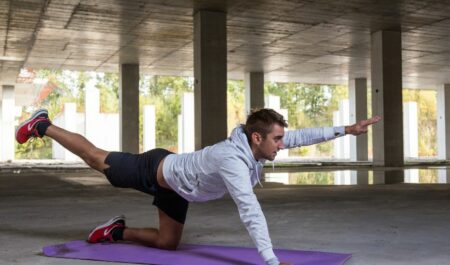
- Put yourself in the position of a table by beginning on your hands and knees. Maintain a neutral spine.
- Extend one of your arms in front of you until it is at the same level as your head and torso.
- Place the opposing arm and leg in line with your body as you extend the opposite leg behind you. Make sure that your hips are pointing toward the floor rather than out to the side, since this will help you maintain proper form. You ought to be able to feel the muscles in your abdominal region and your back working.
- After holding this position for five seconds, switch to the opposite arm and leg and repeat the exercise.
The Dead Bug
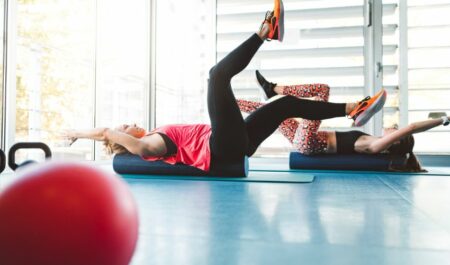
- Lay on your back with your legs bent and your feet on the ground in a flat position.
- Pull your abdominal muscles in toward your spine and maintain a flat back while you rise your knees to create a 90-degree angle between your hips and knees.
- Tap the bottom of one foot slowly and then return to the starting position.
- Extending your arms in a straight line up and over your shoulders will make the exercise more difficult. While you bring one foot to the floor, reach the opposing arm back overhead. Be sure to keep your lower back on the floor and your ribs pulled in throughout the movement.
- You should just extend your leg as far as you can while still maintaining a flat back.
- Turn around and try it the other way.
The Bridge
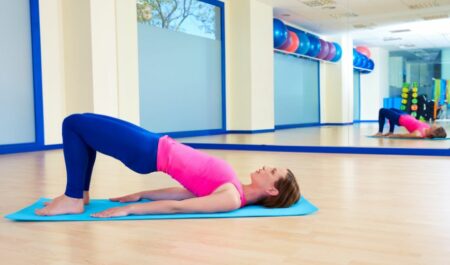
- Place yourself on your back with your knees bent and your feet hip-distance apart. Hold this position for one minute.
- Maintain the connection between your upper body and pelvis as you tighten your buttocks and lift them off the ground.
- Wait for the count of five before releasing.
- Take a deep breath and place your trunk on the ground. Repeat.
What Function Does The Core Serve?
Your core is responsible for a wide variety of processes, including stabilization, balance, breathing, and the control of your bowels and bladder.
Spinal Mobility.
Even while we usually think of the core muscles as being crucial stabilizers (because they are! ), they are also the muscles that are responsible for moving your spine during flexion, extension, lateral flexion, and rotation.
Trunk Stability
When you engage in motions that require you to raise an object over your head, pick something up from the ground, or push or pull an object, the muscles in your core contract to support your trunk and spine and keep your trunk stable.
Weightlifting and other types of physical competition, such as judo, running, and soccer, place significant demands on these muscles. Maintaining a stable spine lowers the likelihood of suffering an injury.
Balance.
When you are standing stationary or when your balance is being challenged in a dynamic way, the core muscles in your body contribute to the maintenance of your equilibrium.
For instance, when someone accidentally brushes up against you, your brain and trunk are able to detect the sudden force applied to you and the shift in your balance. Your abdominal muscles will next respond by helping to keep your body in an upright position.
When you engage in activities like Olympic weightlifting, which require your trunk to react and remain steady despite shifts in weight distribution, the core muscles in your body provide additional support for your balance.
Breathing And Trunk Stability.
One of the primary muscles that regulates breathing is called the diaphragm. It is designed in the shape of an upside-down “U” and lines your lower ribs.
When you take a breath in, it flattens out as it contracts, making room for your lungs to expand and fill the space. On the other hand, when your diaphragm relaxes, it compresses your lung cavity, which, in a manner analogous to how bagpipes function, causes air to be expelled from your lungs.
In addition, when you’re working hard to lift something heavy, your diaphragm can contract in an isometric manner, which causes you to hold your breath. This action will support your trunk, so preventing injury and ensuring that you remain stable.
Bowel And Bladder Control.
Your pelvic floor muscles assist in the regulation of your bowel and bladder, which enables you to urinate or defecate (or to hold it if you can’t make it to the bathroom). These muscles also contribute to the stability of your pelvis.
Incontinence is the medical term for the condition that happens when these muscles are weak. On the other hand, in many instances, these muscles can be strengthened to assist in the prevention of or the management of this ailment.
In addition, the muscles of the pelvic floor and the diaphragm collaborate with the muscles of the rest of your core to increase the amount of abdominal pressure that is exerted at your spine. This helps to maintain the stability of your spine.
Scenarios That Get You Involved On A Core Muscles.
You activate your core in response to a range of fundamental situations, including the following:
Sitting.
Maintain a tall and upright posture with a straight back that is not arched. To strengthen your core, draw your belly button in toward your spine. You can also tense your stomach as though someone were ready to punch you in the gut. This will help you prepare for the blow.
Breathing.
Let your abdominal muscles, shoulders, and neck loosen up. Take a few deep breaths in while allowing your tummy to slowly expand as you do so. You should make an effort to reduce the degree that your shoulders raise (or shrug) toward your ears because this indicates that you are using the auxiliary muscles in your shoulders and neck to breathe.
Weightlifting.
When you perform resistance exercises that require you to hold weight in your arms, such as bicep curls, squats, deadlifts, and military presses, your abdominal muscles are forced to activate. You can also work one side of your body more than the other by performing exercises with one arm or one leg at a time.
Free weight activities were shown to have the highest rate of voluntary core contraction, according to one study that compared various workouts.
Cardio.
The engagement of the core is required for cardiovascular activities because these activities involve multiple movements in a variety of directions.
Yoga.
This common activity engages the core in a number of different movements, such as planks, bridges, and side planks, as well as balancing on one or both feet for poses such as Tree Pose and Warrior Pose, amongst others.
Pilates.
Pilates is an effective method for strengthening the core, and it may be used effectively in both mobility and stability exercises. Pilates is perfect for learning to engage your deep core muscles because it places a focus on providing deep spinal stability. When taught well, Pilates is ideal.
The Conclusion
When you engage your core, you are engaging the muscles in your trunk to give support for your spine and pelvis, both when you are in a static position and when you are moving dynamically. These muscles are responsible for maintaining balance as well as lifting, pushing, and pulling motions, as well as general movement.
A strong core can assist improve your balance, reduce the likelihood of injury, and provide support for your spine during strenuous exercise.
To put it another way, the mobility and stability of your spine are both dependent on the core muscles in your body. They make up the “center” of every movement that your body does over the course of a typical day. The ability to efficiently engage these muscles will allow you to move without experiencing pain for many years to come.
